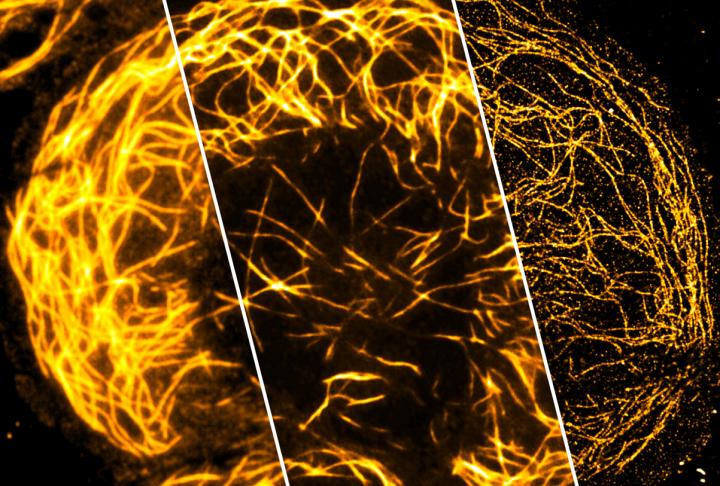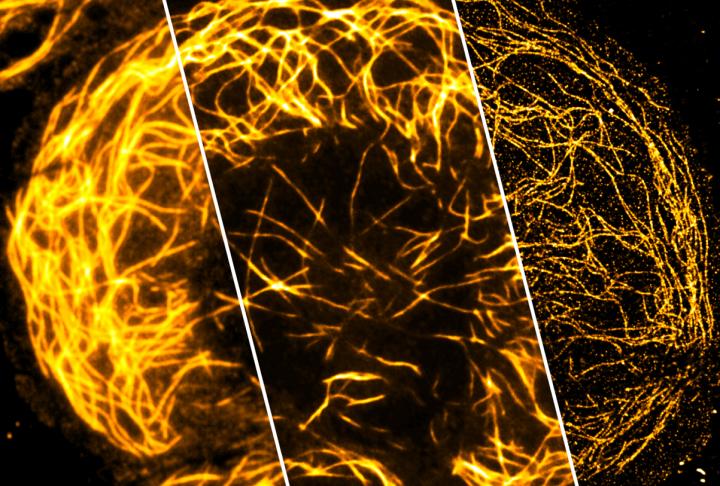
Credit: Photo: Bielefeld University/Robin Diekmann
This information can be used to produce images with a resolution of about 20 to 30 nanometres, and thereby ten times that of conventional light microscopy. Until now, this method has required the use of expensive special instruments. Bielefeld University and the University of Tromsø have filed a patent for this new 'chip-based nanoscopy' procedure. On the 24th of April 2017 the researchers will be publishing the accompanying study in the journal 'Nature Photonics'.
Physicists at Bielefeld University and the Arctic University of Norway in Tromsø have developed a photonic chip that makes it possible to carry out superresolution light microscopy, also called 'nanoscopy', with conventional microscopes. In nanoscopy, the position of single fluorescent molecules can be determined with a precision of just a few nanometres, that is, to a millionth of a millimetre. This information can be used to produce images with a resolution of about 20 to 30 nanometres, and thereby ten times that of conventional light microscopy. Until now, this method has required the use of expensive special instruments. Bielefeld University and the University of Tromsø have filed a patent for this new 'chip-based nanoscopy' procedure. On the 24th of April 2017 the researchers will be publishing the accompanying study in the journal 'Nature Photonics'.
Dr. Mark Schüttpelz from Bielefeld University and Dr. Balpreet Singh Ahluwalia (University of Tromsø) are the inventors of this photonic waveguide chip. Professor Dr. Thomas Huser and Robin Diekmann from Bielefeld University's Biomolecular Photonics Group also worked on developing this new concept. The invention makes experiments much easier to perform: a probe is illuminated directly on a chip about the size of a specimen slide. A lens and a camera record the signal perpendicular to the chip. The measurement data obtained can be reconstructed as superresolved images with a markedly higher resolution than that obtained with conventional microscopy.
Whereas the images that can be obtained simultaneously with established nanoscopy techniques range from only parts of cells up to just a few cells, the use of photonic chips now makes it possible to visualise more than 50 cells in one superresolution image. 'The invention of the new chip-based superresolution technique is a paradigm shift in microscopy, and it will now permit a much broader use of nanoscopy in science, research, and everyday applications,' says Dr. Mark Schüttpelz.
Current nanoscopic techniques are extremely complex, expensive, and require intensively trained technicians. Up to now, these limitations have restricted the use of nanoscopy to only highly specialized institutes throughout the world and prevented its spread to standard laboratories in biology and medicine let alone to hospitals and analytical laboratories.
The invention of the 'chip-based nanoscopy' procedure by researchers at Bielefeld and Tromsø will take its place in the long history of developments in microscopy and nanoscopy:
- In 1609, Galileo Galilei invented light microscopy.
- In 1873, Ernst Abbe discovered the fundamental property that limits the resolution of an optical system for visible light to roughly 250 nanometres.
- In recent years, several optical methods have been developed concurrently in order to overcome the diffraction limit of light. In 2014, the Nobel Prize for Chemistry was awarded for the development of a superresolution in the range of roughly 20 to 30 nanometres.
###
Original publication:
Diekmann R., Helle Ø.I., Øie C.I., McCourt P., Huser T.R., Schüttpelz M., Ahluwalia B.S.: Chip-based wide field-of-view nanoscopy, Nature Photonics, http://dx.doi.org/10.1038/nphoton.2017.55, published on the 24th of April 2017
Contact:
Dr. Mark Schüttpelz, Bielefeld University
Faculty of Physics
Telephone: 0521 106-5445
Email: [email protected]
Media Contact
Dr. Mark Schuettpelz, Bielefeld University
[email protected]
49-052-110-65445
@uniaktuell
http://www.uni-bielefeld.de/
############
Story Source: Materials provided by Scienmag





